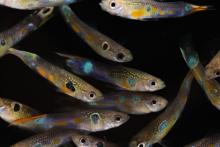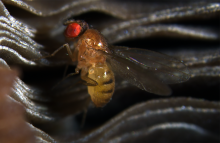Beaty Biodiversity Museum Director Wayne Maddison has uncovered 30 to 50 never-before-identified species of jumping spiders as part of a Conservation International expedition to Papua New Guinea.
The discovery gives scientists a peek into a section of the evolutionary tree previously thought to be sparse, and could have implications for the development of medicines.
Jumping spiders are found in every part of the world. Capable of jumping 30 times their body length, some of the 5,000 documented species are common in households.
"Instead of sitting at the centre of a web, jumping spiders found a new way to make a living by wandering around their habitat and pouncing - like cats - on their prey," says Maddison, a professor of zoology and botany, and director of UBC's new biodiversity-focused natural history museum, set to open early next year.
Two of the jumping spiders' eight eyes have evolved to be large with high-resolution vision to spot prey. Female jumping spiders also use this heightened visual sense to watch males, who show off their colourful bodies during courtship dances.
Maddison collected more than 500 individual spiders during an expedition with Conservation International (CI) last summer in the Kaijende Uplands, one of Papua New Guinea's largest undeveloped areas. As many as 30 to 50 never-before-identified species may have been found on the trip.
Some of the species discovered are highly distinctive, occupying "lonely" branches on the evolutionary tree of jumping spiders. Further research on these new specimens will shed light on how jumping spiders evolved their unique features - a question that continues to puzzle scientists.
"Our finding shows that the great age of discovery isn't over by far," says Maddison, who estimates there may be at least 5,000 more species of unidentified jumping spiders in the world.
The CI expedition also identified two new plants, three frogs and a gecko that are believed to be new to science. Maddison says the smaller animals - like insects and spiders - and plants may hold the secret to many of the world's unknown chemicals.
"Spider venom has evolved for millions of years to affect the neurological systems of the spider's insect prey, and each species of spider gives us another opportunity to find medically useful chemicals," says Maddison. "Jumping spiders with their remarkably miniaturized yet acute eyes could help us understand how to push the limits of vision. In addition to filling in the gaps in our planet's natural history, exploring spider biodiversity and evolution could potentially inform fields as diverse as medicine and robotics."
"More than anything else, it's an amazingly beautiful world and we're simply trying to reveal it. There is a whole lot of beauty in these small spiders if we look closely enough."
For more information on the newly discovered spiders, photos and videos, visit: www.beatymuseum.ubc.ca/spiders
Musqueam First Nation land acknowledegement
We honour xwməθkwəy̓ əm (Musqueam) on whose ancestral, unceded territory UBC Vancouver is situated. UBC Science is committed to building meaningful relationships with Indigenous peoples so we can advance Reconciliation and ensure traditional ways of knowing enrich our teaching and research.
Learn more: Musqueam First Nation
Faculty of Science
Office of the Dean, Earth Sciences Building2178–2207 Main Mall
Vancouver, BC Canada
V6T 1Z4


